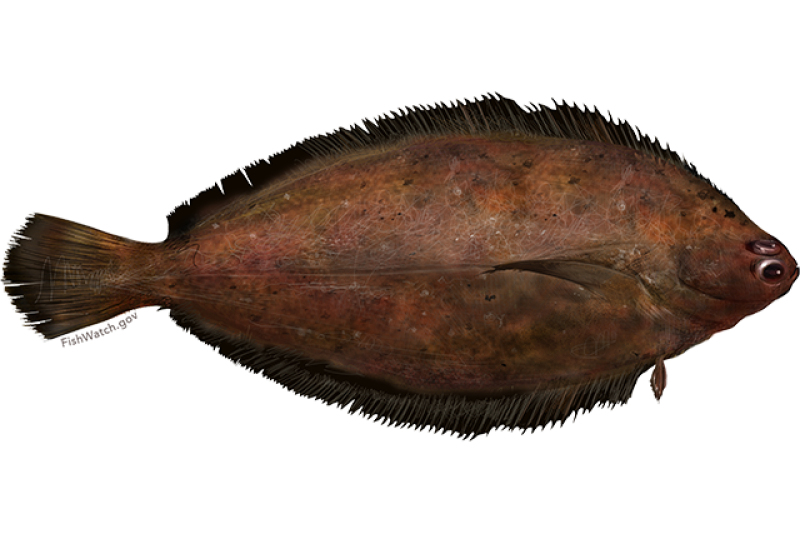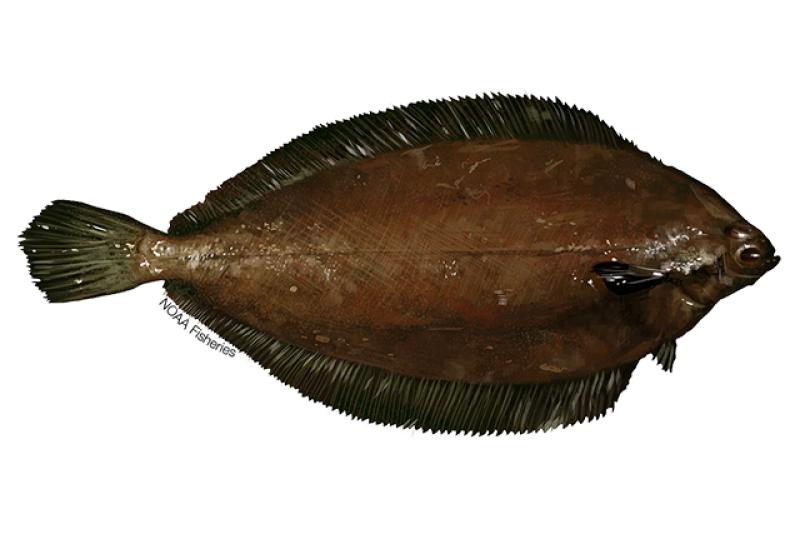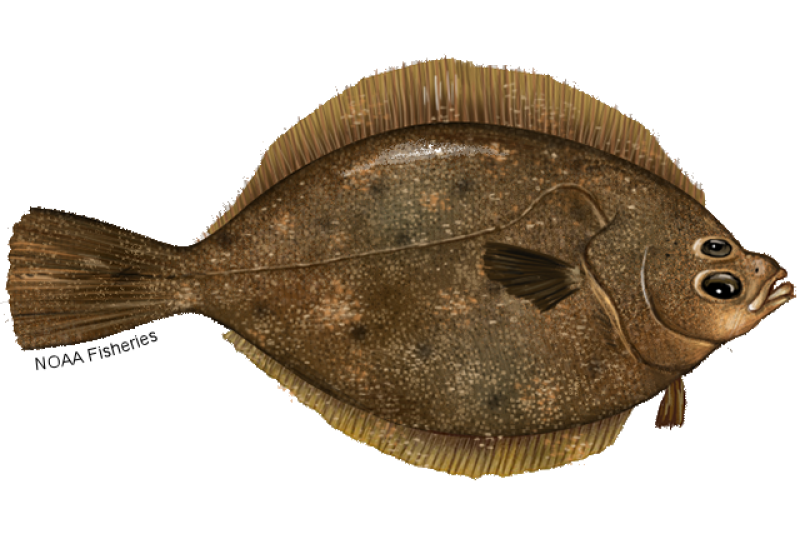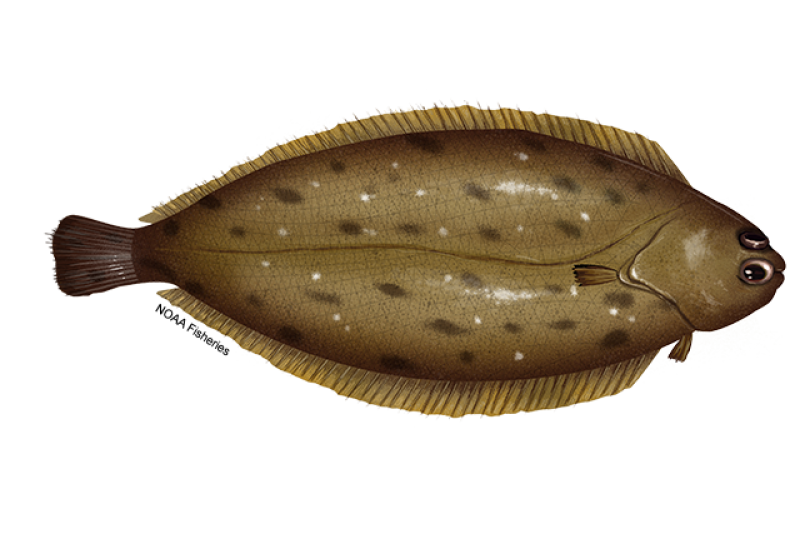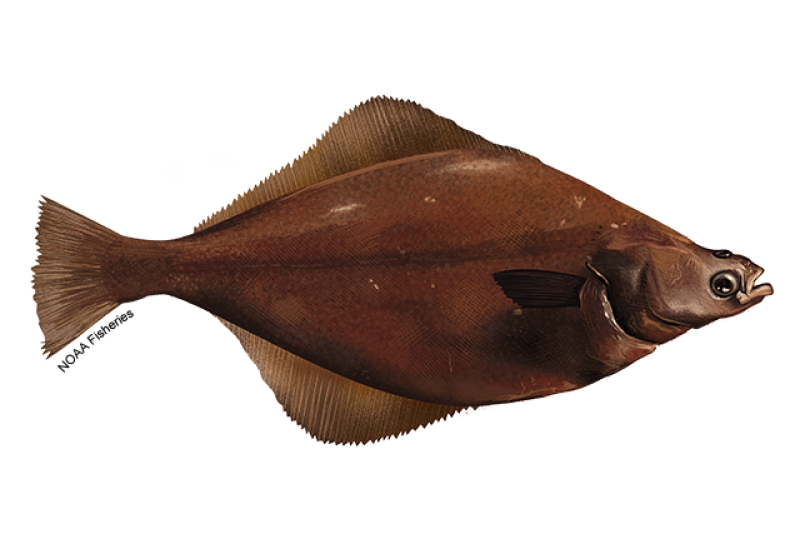About the Species
U.S. wild-caught rex sole is a smart seafood choice because it is sustainably managed and responsibly harvested under U.S. regulations.

Population
The Gulf of Alaska and Pacific Coast stocks are not overfished.

Fishing Rate
Not subject to overfishing.

Habitat Impact
Area closures and gear restrictions protect habitats that are affected by bottom trawls used to harvest rex sole.

Bycatch
Regulations are in place to minimize bycatch.
Population Status
- There are three stocks of rex sole: Gulf of Alaska, Pacific coast, and one stock contained in the Bering Sea/Aleutian Islands Other Flatfish Complex. According to the most recent stock assessments:
- The Gulf of Alaska stock is not overfished based on the assessment of rex sole - Eastern Gulf of Alaska (2022 stock assessment) and rex sole - Western Gulf of Alaska (2022 stock asessment), and not subject to overfishing based on 2023 catch data. Summary stock assessment information for rex sole - Eastern Gulf of Alaska can be found on Stock SMART and rex sole - Western Gulf of Alaska can be found on Stock SMART.
- The Pacific coast stock is not overfished (2023 stock assessment). Rex sole is part of the Other Flatfish Complex and the complex is not subject to overfishing based on 2022 catch data. Summary stock assessment information can be found on Stock SMART.
- The population status of the Bering Sea/Aleutian Islands Other Flatfish Complex, which includes rex sole, has been assessed (2020 stock assessment), but there is not enough information to determine the population size so the population status is unknown. This complex is not subject to overfishing based on 2023 catch data. Summary stock assessment information can be found on Stock SMART.
Appearance
- Rex sole is a flatfish with both eyes located on the right side of its head.
- They have small mouths with a blunt, rounded snout. Their body is oval, but elongated, and very slender.
- The upper side of their body is light brown to gray in color and their underside is white.
Biology
- Rex sole are moderately long-lived (they can live for nearly 30 years), and can grow up to 23 inches.
- Female rex sole grow faster and live longer than males.
- Depending on location, rex sole may reach maturity between 3.5 and 13 years.
- Rex sole spawn from October through May. They are serial spawners, and will deposit eggs on more than one occasion throughout the spawning season. The spawning season may be longer in the Gulf of Alaska.
- Eggs are fertilized near the sea bed, move into the water column, and require a few weeks to hatch. Once hatched, larvae spend about a year in the water column before settling to the bottom as juveniles.
- Rex sole feed on shrimp, amphipods, and worms.
- Sharks, skates, rays, lingcod, arrowtooth flounder, and some species of rockfish prey on rex sole.
Where They Live
Range
- Rex sole are found from central Baja California to the Bering Sea.
Habitat
- Rex sole live on sandy or muddy ocean bottoms.
- They are found at depths between 100 and 200 meters and are found throughout the Gulf of Alaska.
- Along the coast of the Pacific Northwest they are found at depths of about 500 meters.
Fishery Management
- NOAA Fisheries and the Pacific Fishery Management Council manage the rex sole fishery on the West Coast.
- Managed under the Pacific Coast Groundfish Fishery Management Plan:
- Limits on the number of permits and fishermen allowed.
- Limits on the minimum size of fish that may be harvested.
- Limit on how much may be harvested in one fishing trip.
- Certain seasons and areas are closed to fishing.
- Observers are required and gear restrictions help reduce bycatch and impacts on habitat.
- A trawl rationalization catch share program includes:
- Catch limits based on the population information for each fish stock and divided into shares that are allocated to individual fishermen or groups.
- These fishermen can decide how and when to catch their share – preferably when weather, markets, and business conditions are most favorable, allowing the fishery the flexibility to be more environmentally responsible, safer, more efficient, and more valuable.
- NOAA Fisheries and the North Pacific Fishery Management Council manage the rex sole fishery in Alaska.
- Managed under the Gulf of Alaska Groundfish Fishery Management Plan:
- Total allowable catch is allocated by regulatory area (western, central, and two sub-areas of the eastern Gulf of Alaska).
- Managed under the Bering Sea/Aleutian Islands Groundfish Fishery Management Plan.
- In the Gulf of Alaska, Bering Sea, and Aleutian Islands:
- Fishermen must have a permit to participate in these fisheries, and the number of available permits is limited to control the amount of fishing.
- Managers determine how much rex sole can be caught. Catch is monitored through record keeping, reporting requirements, and observer monitoring.
Harvest
- In 2023, landings of rex sole totaled 4.7 million pounds and were valued at $1.3 million, according to the NOAA Fisheries commercial fishing landings database.
- Gear types, habitat impacts, and bycatch:
- Bottom trawls are used to catch rex sole.
- Trawls that are used to harvest rex sole can contact the ocean floor and impact habitats, depending on the characteristics of the ocean bottom and the size of the gear.
- Bottom trawls cause minimal damage to habitat when targeting rex sole over soft, sandy, or muddy ocean bottoms on the West Coast and in Alaska.
- In Alaska and on the West Coast, NOAA Fisheries and the regional fishery management councils have implemented large closed areas to protect sensitive rocky, cold-water coral and sponge habitats from bottom trawls.
- Vessel monitoring systems allow enforcement staff and fishery managers to monitor GPS locations of fishing activities to ensure vessels are complying with closed areas.
- In Alaska, there are limits on the amount of halibut and crab that groundfish fisheries can incidentally catch. If the limit is reached, managers close the fishery for the remainder of the season.
Scientific Classification
- Rex sole are found from central Baja California to the Bering Sea.
- Rex sole live on sandy or muddy ocean bottoms.
- They are found at depths between 100 and 200 meters and are found throughout the Gulf of Alaska.
- Along the coast of the Pacific Northwest they are found at depths of about 500 meters.
Fishery Management
- NOAA Fisheries and the Pacific Fishery Management Council manage the rex sole fishery on the West Coast.
- Managed under the Pacific Coast Groundfish Fishery Management Plan:
- Limits on the number of permits and fishermen allowed.
- Limits on the minimum size of fish that may be harvested.
- Limit on how much may be harvested in one fishing trip.
- Certain seasons and areas are closed to fishing.
- Observers are required and gear restrictions help reduce bycatch and impacts on habitat.
- A trawl rationalization catch share program includes:
- Catch limits based on the population information for each fish stock and divided into shares that are allocated to individual fishermen or groups.
- These fishermen can decide how and when to catch their share – preferably when weather, markets, and business conditions are most favorable, allowing the fishery the flexibility to be more environmentally responsible, safer, more efficient, and more valuable.
- NOAA Fisheries and the North Pacific Fishery Management Council manage the rex sole fishery in Alaska.
- Managed under the Gulf of Alaska Groundfish Fishery Management Plan:
- Total allowable catch is allocated by regulatory area (western, central, and two sub-areas of the eastern Gulf of Alaska).
- Managed under the Bering Sea/Aleutian Islands Groundfish Fishery Management Plan.
- In the Gulf of Alaska, Bering Sea, and Aleutian Islands:
- Fishermen must have a permit to participate in these fisheries, and the number of available permits is limited to control the amount of fishing.
- Managers determine how much rex sole can be caught. Catch is monitored through record keeping, reporting requirements, and observer monitoring.
Harvest
- In 2023, landings of rex sole totaled 4.7 million pounds and were valued at $1.3 million, according to the NOAA Fisheries commercial fishing landings database.
- Gear types, habitat impacts, and bycatch:
- Bottom trawls are used to catch rex sole.
- Trawls that are used to harvest rex sole can contact the ocean floor and impact habitats, depending on the characteristics of the ocean bottom and the size of the gear.
- Bottom trawls cause minimal damage to habitat when targeting rex sole over soft, sandy, or muddy ocean bottoms on the West Coast and in Alaska.
- In Alaska and on the West Coast, NOAA Fisheries and the regional fishery management councils have implemented large closed areas to protect sensitive rocky, cold-water coral and sponge habitats from bottom trawls.
- Vessel monitoring systems allow enforcement staff and fishery managers to monitor GPS locations of fishing activities to ensure vessels are complying with closed areas.
- In Alaska, there are limits on the amount of halibut and crab that groundfish fisheries can incidentally catch. If the limit is reached, managers close the fishery for the remainder of the season.
Scientific Classification
| Kingdom | Animalia | Phylum | Chordata | Class | Actinopterygii | Order | Pleuronectiformes | Family | Pleuronectidae | Genus | Glyptocephalus | Species | zachirus |
|---|
Last updated by NOAA Fisheries on 03/21/2025
Featured News
 Offloading frozen Pacific cod from a catcher-processor vessel in Dutch Harbor, Alaska. Credit: NOAA Fisheries / Paul Hillman.
Offloading frozen Pacific cod from a catcher-processor vessel in Dutch Harbor, Alaska. Credit: NOAA Fisheries / Paul Hillman.
Economic Snapshot Shows Alaska Seafood Industry Suffered $1.8 Billion Loss 2022–2023
Seafood Facts

Is Rex Sole Sustainable?
U.S. wild-caught rex sole is a smart seafood choice because it is sustainably managed and responsibly harvested under U.S. regulations.
Availability
Year-round, but highest catch is from February through May.
Source
U.S. wild-caught from Alaska to California (but mainly from Alaska).
Taste
Mild and sweet.
Texture
Tender with fine, firm flakes.
Color
White when raw or cooked.
Health Benefits
Rex sole is an excellent source of low-fat protein.
Nutrition Facts
Servings: 1; Serving Weight: 100 g (raw); Calories: 91; Protein: 18.84 g; Total Fat: 1.19 g; Total Saturated Fatty Acids: 0.283 g; Carbohydrate: 0 g; Total Sugars: 0 g; Total Dietary Fiber: 0 g; Cholesterol: 48 mg; Selenium: 32.7 mcg; Sodium: 81 mgMore Information
Sole Recipes
Looking for some ways to add sole into your rotation? If you need some cooking inspiration, browse these recipes for citrus sole with tahini drizzle, sole sliders, and more!

Last updated by NOAA Fisheries on 03/21/2025
Seafood News
 Fresh-caught taʻape on ice. Credit: Conservation International Hawaiʻi.
Fresh-caught taʻape on ice. Credit: Conservation International Hawaiʻi.
Reducing Waste and Feeding Communities in Hawaiʻi with a Whole Fish Approach
 Chef Tyler Hadfield’s Curried Skate Wings with Tomato-Masala Chutney
Chef Tyler Hadfield’s Curried Skate Wings with Tomato-Masala Chutney
Ring In the New Year With These Crowd-Favorite Seafood Recipes
 NOAA Fisheries, in collaboration with Blue Ocean Mariculture, is conducting a multi-year pilot study to evaluate observational methods and tools for studying Hawaiian monk seal behavior. Courtesy of Blue Ocean Mariculture
NOAA Fisheries, in collaboration with Blue Ocean Mariculture, is conducting a multi-year pilot study to evaluate observational methods and tools for studying Hawaiian monk seal behavior. Courtesy of Blue Ocean Mariculture
AI Meets Aquaculture to Study Hawaiian Monk Seal Interactions With Net Pens
 Tonya Wick aboard a fishing vessel at sea in 1998. Photo courtesy of Tonya Wick
Tonya Wick aboard a fishing vessel at sea in 1998. Photo courtesy of Tonya Wick
Data & Maps
2023 Assessment Of The Rex Sole Stock In The Gulf of Alaska
Rex sole is assessed using an age-structured model and Tier 3 determination within the context of a…
2022 Assessment Of The Rex Sole Stock In The Gulf of Alaska
Rex sole is assessed using an age-structured model and Tier 3 determination within the context of a…
2021 Assessment Of The Rex Sole Stock In The Gulf of Alaska
The key results of the assessment, based on the author’s preferred (base case) model, are compared…
2020 Assessment Of The Rex Sole Stock In The Gulf of Alaska
The key results from the accepted 2019 assessment are shown in the table below with 2021…
Research
2023 North Pacific Groundfish Stock Assessments
2023 North Pacific Groundfish Stock Assessment and Fishery Evaluation Reports for 2024 Fisheries
2022 North Pacific Groundfish Stock Assessments
2022 North Pacific Groundfish Stock Assessment and Fishery Evaluation Reports for 2023 Fisheries
North Pacific Groundfish Stock Assessments and Fishery Evaluation Reports
Alaska Groundfish Stock Assessments, Economic Status Reports, and Ecosystem Status Reports.
2021 North Pacific Groundfish Stock Assessments
2021 North Pacific Groundfish Stock Assessment and Fishery Evaluation Reports for 2022 Fisheries
Last updated by NOAA Fisheries on 03/21/2025
